Assessing the Biodegradability of PHB-Based Materials with Different Surface Areas: A Comparative Study on Soil Exposure of Films and Electrospun Materials
Abstract
1. Introduction
2. Materials and Methods
2.1. Materials
2.2. Methods
2.2.1. Scanning Electron Microscopy (SEM)
2.2.2. Optical Microscopy
2.2.3. Surface Density, Thickness and Porosity Estimation
2.2.4. Mechanical Analysis
2.2.5. Differential Scanning Calorimetry (DSC)
2.2.6. Infrared Spectroscopy (FTIR)
2.2.7. Composting in Soil
3. Results
4. Conclusions
Author Contributions
Funding
Institutional Review Board Statement
Data Availability Statement
Acknowledgments
Conflicts of Interest
References
- Bharti, S.N.; Swetha, G. Need for Bioplastics and Role of Biopolymer PHB: A Short Review. J. Pet. Environ. Biotechnol. 2016, 7, 5–8. [Google Scholar]
- Mohd Ishak, Z.A.; Ahmad Thirmizir, M.Z. Editorial corner-a personal view producing green composites via polymer blending. Express Polym. 2021, 15, 910–911. [Google Scholar] [CrossRef]
- Ugur, A.; Sahin, N.; Beyatli, Y. Accumulation of poly-hydroxybutyrate in Streptomyces species during growth with different nitrogen sources. Turk. J. Biol. 2002, 26, 171. [Google Scholar]
- Krutko, E.T.; Prokopchuk, N.R.; Globa, A.I. Natural biodegradable poly-measures. In Book Technology of Biodegradable Polymer Materials, 1st ed.; Krul, L.P., Kudina, E.F., Eds.; Belarusian State Technological University: Minsk, Belarus, 2014; Volume 1, p. 105. [Google Scholar]
- Raza, Z.A.; Khalil, S.; Abid, S. Recent progress in development and chemical modification of poly(hydroxybutyrate)-based blends for potential medical applications. Int. J. Biol. Macromol. 2020, 160, 77–100. [Google Scholar] [CrossRef] [PubMed]
- Ansari, S.; Fatma, T. Polyhydroxybutyrate-a Biodegradable Plastic and its Various Formulations. Int. J. Innov. Res. Sci. Eng. Technol. 2014, 3, 5. [Google Scholar]
- Sreedevi, S.; Unni, K.N.; Sajith, S.; Priji, P.; Josh, M.S.; Benjamin, S. Bioplastics: Advances in poly-3-hydroxybutyrate research. In Advances in Polymer Science; Springer: Berlin/Heidelberg, Germany, 2014; pp. 1–30. [Google Scholar]
- Woolnough, C.A.; Yee, L.H.; Charltonb, T.; Fostera, L.G.R. Environmental degradation and biofouling of ‘green’ plastics including short and medium chain length polyhydroxyalkanoates. Polym. Int. 2009, 59, 658–667. [Google Scholar] [CrossRef]
- Weng, Y.-X.; Wang, X.-L.; Wang, Y.-Z. Biodegradation behavior of PHAs with different chemical structures under controlled composting conditions. Polym. Test. 2011, 30, 372–380. [Google Scholar] [CrossRef]
- Quispe, M.M.; Lopez, O.V.; Boina, D.A.; Stumb, J.F.; Villar, M.A. Glycerol-based additives of poly(3-hydroxybutyrate) films. Polym. Test. 2021, 93, 15. [Google Scholar] [CrossRef]
- Bonartsev, A.P.; Bonartseva, G.A.; Reshetov, I.V.; Kirpichnikov, M.P.; Shaitan, K.V. Application of polyhydroxyalkanoates in medicine and the biological activity of natural poly(3-Hydroxybutyrate). Acta Nat. 2019, 11, 4–16. [Google Scholar] [CrossRef]
- Rodrigo, T.U.; Felisbert, M.I. Plasticization of poly(3-hydroxybutyrate) with triethyl citrate: Thermal and mechanical properties, morphology, and kinetics of crystallization. J. Appl. Polym. Sci. 2020, 138, 14. [Google Scholar]
- Râpă, M. Raluca Nicoleta Darie-Nita Effect of plasticizers on melt processability and properties of PHB. J. Optoelectron. Adv. Mater. 2015, 17, 1778–1784. [Google Scholar]
- Yu, J.; Stahl, H. Microbial utilization and biopolyester synthesis of bagasse hydrolysates. Bioresour. Technol. 2008, 99, 7. [Google Scholar] [CrossRef] [PubMed]
- Reinerte, S.; Kirpluks, M.; Cabulis, U. Thermal degradation of highly crosslinked rigid PU-PIR foams based on high functionality tall oil polyol. Polym. Degrad. Stab. 2019, 167, 50–57. [Google Scholar] [CrossRef]
- Jeepery, F.I.; Sudesh, K.; Abe, H. Miscibility and enzymatic degradability of poly(3-hydroxybutyrate-co-3-hydroxyhexanoate)-based polyester blends by PHB depolymerase and lipase. Polym. Degrad. Stab. 2021, 192, 12. [Google Scholar] [CrossRef]
- Tosin, M.; Pischedda, A.; Degli-Innocenti, F. Biodegradation kinetics in soil of a multi-constituent biodegradable plastic. Polym. Degrad. Stab. 2019, 166, 213–218. [Google Scholar] [CrossRef]
- Poltronieri, P.; Mezzolla, V.; D’Urso, O.F. PHB Production in Biofermentors Assisted through Biosensor Applications. Proceedings 2016, 1, 4. [Google Scholar] [CrossRef]
- Rutkowska, M.; Krasowska, K.; Heimowska, A.; Adamus, G.; Sobota, M.; Musioł, M.; Janeczek, H.; Sikorska, W.; Krzan, A.; Žagar, E.; et al. Environmental degradation of blends of atactic poly[(R,S)-3-hydroxybutyrate] with natural PHBV in Baltic sea water and compost with activated sludge. J. Polym. Environ. 2008, 16, 183–191. [Google Scholar] [CrossRef]
- Tsuji, H.; Suzuyoshi, K. Environmental degradation of biodegradable polyesters 2 Poly(ε-caprolactone), poly[(R)-3-hydroxybutyrate], and poly(L-lactide) films in natural dynamic seawater. Polym. Degrad. 2002, 75, 357–365. [Google Scholar] [CrossRef]
- Meereboer, K.W.; Misra, M.; Mohanty, A.K. Review of recent advances in the biodegradability of polyhydroxyalkanoate (PHA) bioplastics and their composites. RSoC 2020, 22, 40. [Google Scholar] [CrossRef]
- Marina, P.A.; Perdiguero, M.; Fiori, S.; Kenny, J.M.; Peponi, L. Biodegradable electrospun PLA-PHB fibers plasticized with oligomeric lactic acid. Polym. Degrad. Stab. 2020, 179, 7. [Google Scholar]
- European Bioplastics. Available online: https://www.european-bioplastics.org/new-market-data-the-positive-trend-for-the-bioplastics-industry-remains-stable/ (accessed on 10 February 2023).
- Deroiné, M.; César, G.; Le Duigou, A.; Davies, P.; Bruzaud, S. Natural degradation and biodegradation of poly(3-hydroxybutyrate-co-3-hydroxyvalerate) in liquid and solid marine environments. J. Polym. Environ. 2015, 23, 493–505. [Google Scholar] [CrossRef]
- Altaee, N.; El-Hiti, G.A.; Fahdil, A.; Sudesh, K.; Yousif, E. Biodegradation of different formulations of polyhydroxybutyrate films in soil. Springerplus 2016, 5, 762. [Google Scholar] [CrossRef] [PubMed]
- Muhamad, I.I.; Joon, L.K.; Azemi, M.; Noor, M. Comparing the degradation of poly-β-(hydroxybutyrate), poly-β-(hydroxybutyrate-co-valerate)(PHBV) and PHBV/cellulose triacetate blend. Polym. J. 2006, 1, 39–46. [Google Scholar]
- Mouhoubi, R.; Lasschuijt, M.; Carrasco, S.; Gojzewski, H.; Wurm, F. End-of-life biodegradation? how to assess the composting of polyesters in the lab and the field. Waste Manag. 2022, 154, 36–48. [Google Scholar] [CrossRef]
- Prudnikova, S.V.; Korobikhina, K.I.; Boyandin, A.N.; Volkova, T.G. Regularities of biodegradation of polyhydroxyalkanoates on the territory of Vietnam and Central Siberia. J. Sib. Fed. Univ. Biol. 2012, 3, 311–321. [Google Scholar]
- Fang, L.; David, W. Grainger Fluorinated Biomaterials. In Biomaterials Science; Academic Press: Cambridge, MA, USA, 2013; Volume 5. [Google Scholar]
- Filatov, Y.N. Electrospinning of Fibrous Materials, 1st ed.; Krivchenko, V.N.: Moscow, Russia, 2001; p. 231. [Google Scholar]
- Alsvik, I.L.; Hägg, M.-B. Pressure Retarded Osmosis and Forward Osmosis Membranes: Materials and Methods. Polymers 2013, 5, 303–327. [Google Scholar] [CrossRef]
- Sun, L.; Songa, L.; Zhang, X.; Zhou, R.; Yin, J.; Luan, S. Poly(γ-glutamic acid)-based electrospun nanofibrous mats with photodynamic therapy for effectively combating wound infection. Mater. Sci. Eng. A 2020, 113, 10. [Google Scholar] [CrossRef]
- Zhu, G.; Kremenakova, D.; Wang, Y.; Militky, J. Air permeability of polyester nonwoven fabrics. Autex Res. J. 2015, 15, 8–12. [Google Scholar] [CrossRef]
- Varyan, I.; Tyubaeva, P.; Kolesnikova, N.; Popov, A. Biodegradable Polymer Materials Based on Polyethylene and Natural Rubber: Acquiring, Investigation, Properties. Polymers 2022, 14, 2457. [Google Scholar] [CrossRef]
- GOST R 53381-2009; Soils and Soils Are Nutritious Soils. Technical Conditions: Date of Introduction 2010-07-01. Standartinform: Moscow, Russia, 2009.
- Chuan, J.; Yeo; Muiruri, J.; Thitsartarn, W.; Li, Z.; He, C. Recent advances in the development of biodegradable PHB-based toughening materials: Approaches, advantages and applications. Mater. Sci. Eng. C 2018, 92, 4. [Google Scholar]
- Zykova, A.; Morokov, E.; Tyubaeva, P. Influence of Processing Methods on the Mechanical Behavior of Poly-3-hydroxybutyrate Nonwoven Scaffolds. Macromol. Symp. 2022, 404, 1092–1116. [Google Scholar] [CrossRef]
- Khramtsova, E.; Morokov, E.; Antipova, C.; Krasheninnikov, C.; Lukanina, K.; Grigoriev, T. How the Nonwoven Polymer Volume Microstructure Is Transformed under Tension in an Aqueous Environment. Polymers 2022, 14, 13. [Google Scholar] [CrossRef] [PubMed]
- Yano, T.; Higaki, Y.; Tao, D.; Murakami, D.; Kobayashi, M.; Ohta, N.; Koike, J.; Horigome, M.; Masunaga, H.; Ogawa, H.; et al. Orientation of poly(vinyl alcohol) nanofiber and crystallites in non-woven electrospun nanofiber mats under uniaxial stretching. Polymer 2012, 53, 4702–4708. [Google Scholar] [CrossRef]
- GOST 28840-90; Machines for Testing Materials for Tension, Compression and Bending: Date of Introduction 1993-01-01. Resolution of the State Standard: Moscow, Russia, 29 December 1990; 8p.
- Spivak, L.V.; Simonov, Y.N.; Dyshlyuk, M.A. Differential scanning calorimetry: New experimental possibilities. Physics 2019, 3, 52–57. [Google Scholar]
- Volova, T.G.; Boyandin, A.N.; Prudnikov, S.V. Biodegradation of Polyhydroxyalkanoates in Natural Soils. J. Sib. Fed. Univ. 2015, 8, 152–167. [Google Scholar] [CrossRef]
- Redkin, N.A. IR-Fourier Spectrometry and Mass Spectrometry in the Identification of Organic Compounds, 1st ed.; Samara University: Samara, Russia, 2019; p. 92. [Google Scholar]
- Kuptsov, A.H.; Zhizhin, G.N. Fourier-KR and Fourier-IR Spectra of Polymers, 1st ed.; M. Fizmatlit: Moscow, Russia, 2013; p. 657. [Google Scholar]
- Salomez, M.; George, M.; Fabre, P.; Touchaleaume, F.; Cesar, G.; Lajarrige, A.; Gastaldi, E. A comparative study of degradation mechanisms of PHBV and PBSA under laboratory-scale composting conditions. Polym. Deg. Stab. 2019, 167, 102–113. [Google Scholar] [CrossRef]
- Manna, A.; Paul, A.K. Degradation of microbial polyester poly(3-hydroxybutyrate) in environmental samples and in culture. Biodegradation 2000, 11, 323–329. [Google Scholar] [CrossRef]
- Guerin, P.; Renard, E.; Langlois, V. Degradation of natural and artificial poly[(R)-3-hydroxyalkanoate]s: From biodegradation to hydrolysis. Microbiology 2010, 14, 284–313. [Google Scholar]
- Sudesh, K.; Abe, H.; Doi, Y. Synthesis, structure and properties of polyhydroxyalkanoates: Biological polyesters. Prog. Polym. 2000, 25, 1503–1555. [Google Scholar] [CrossRef]
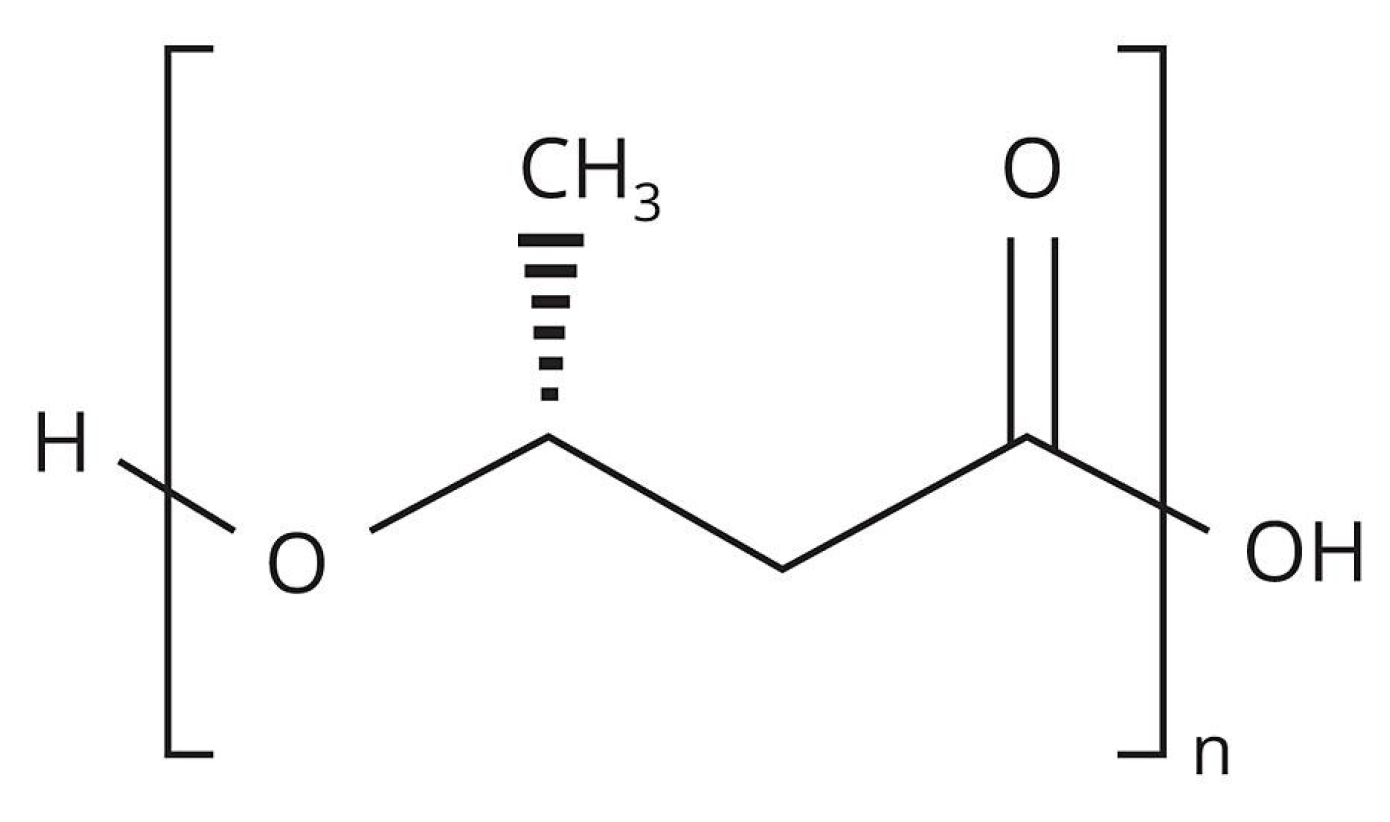
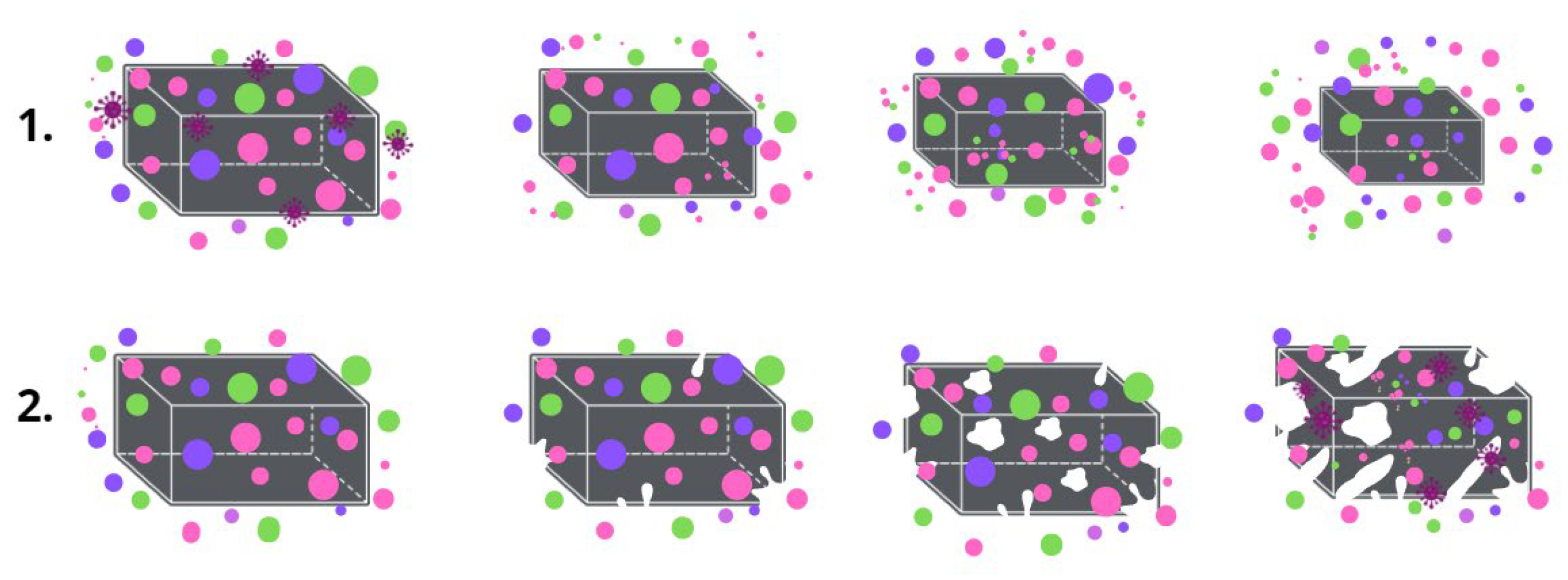
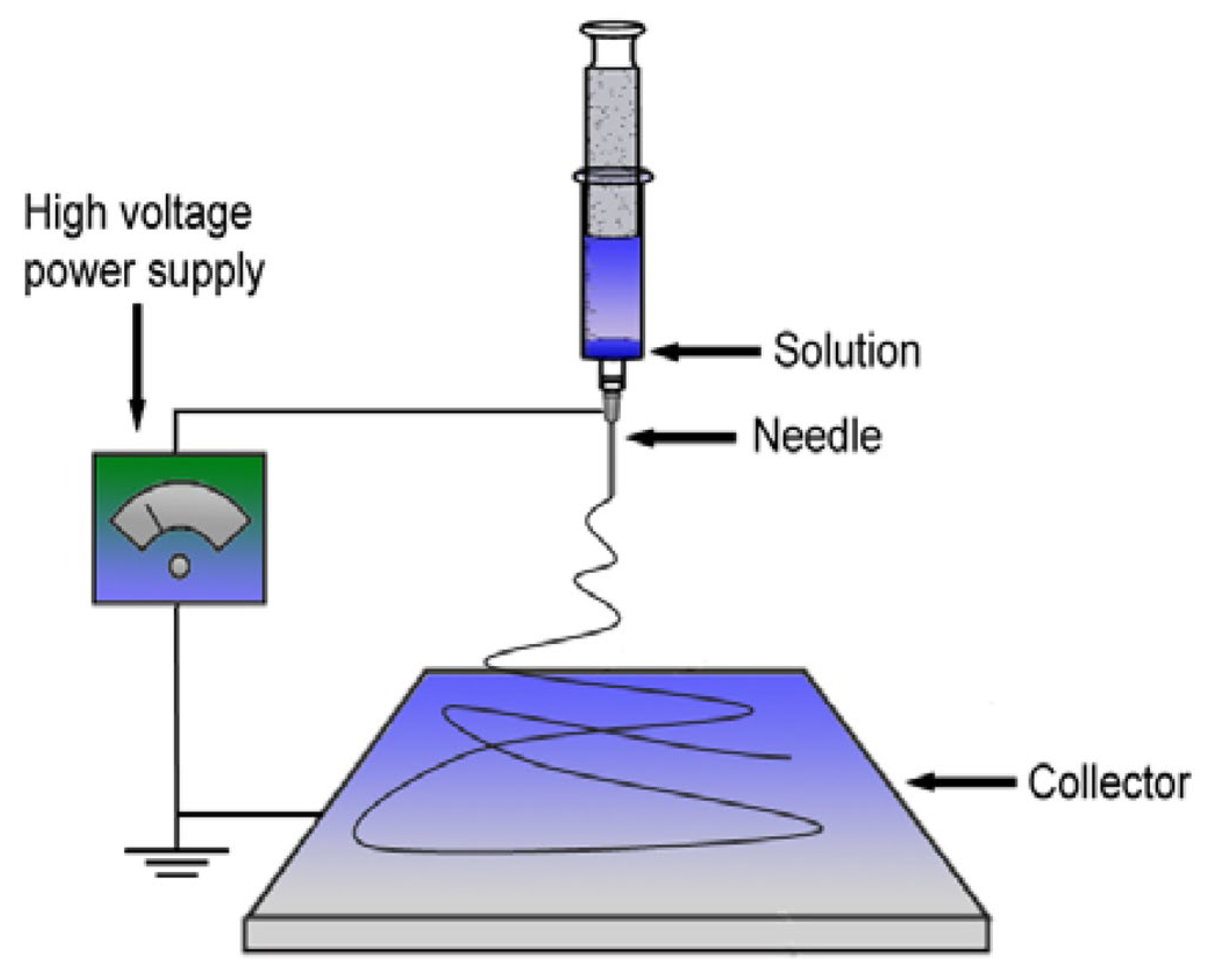
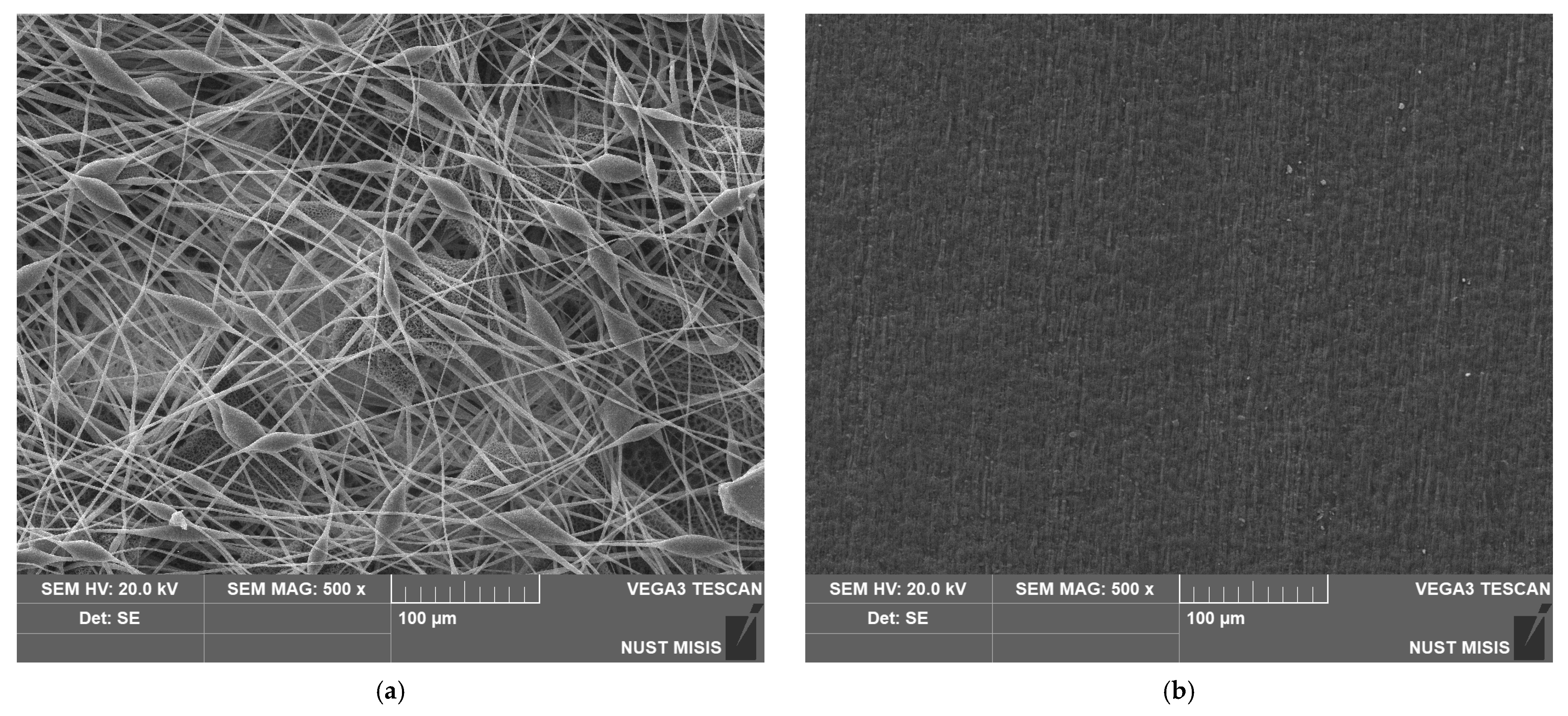
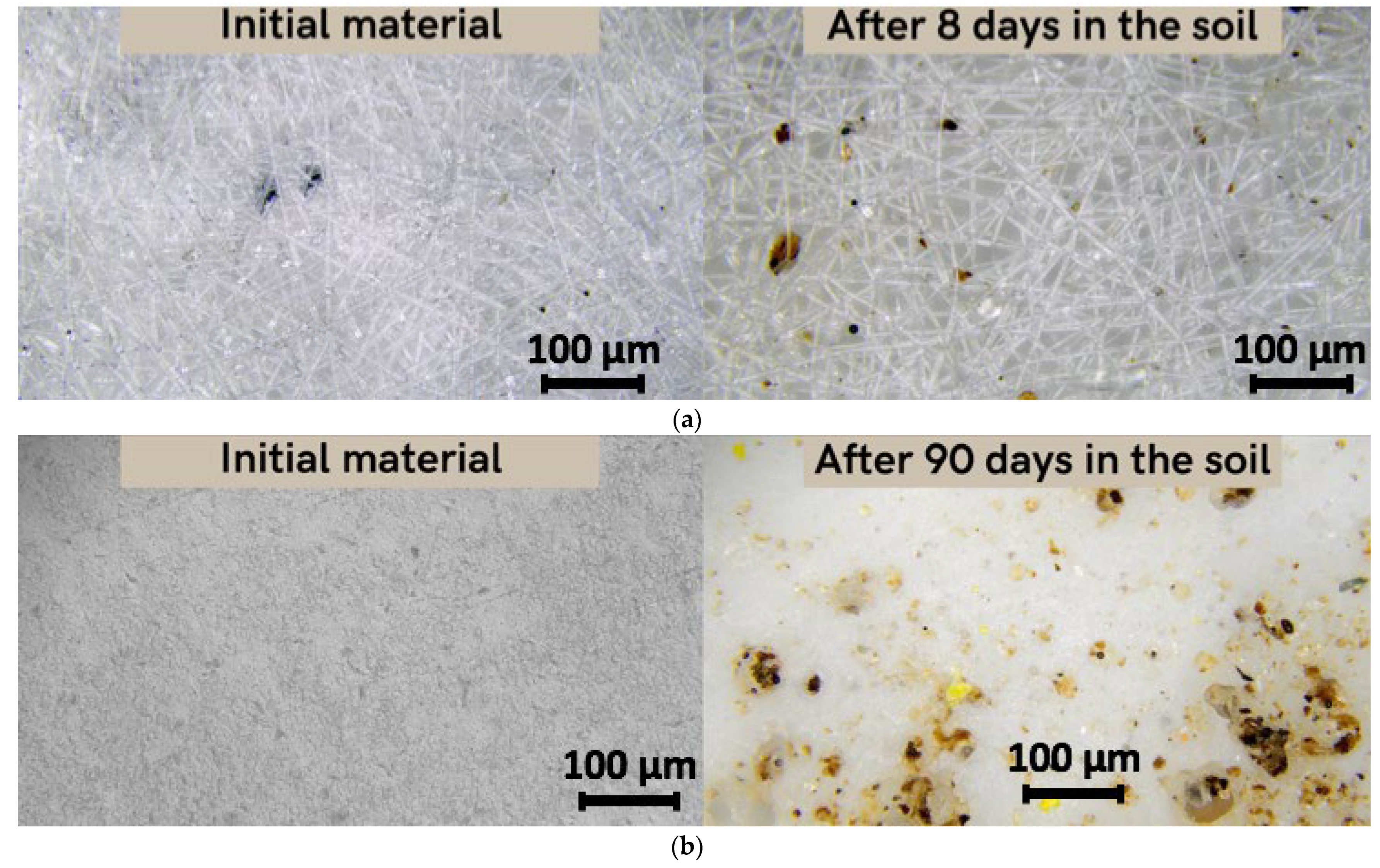

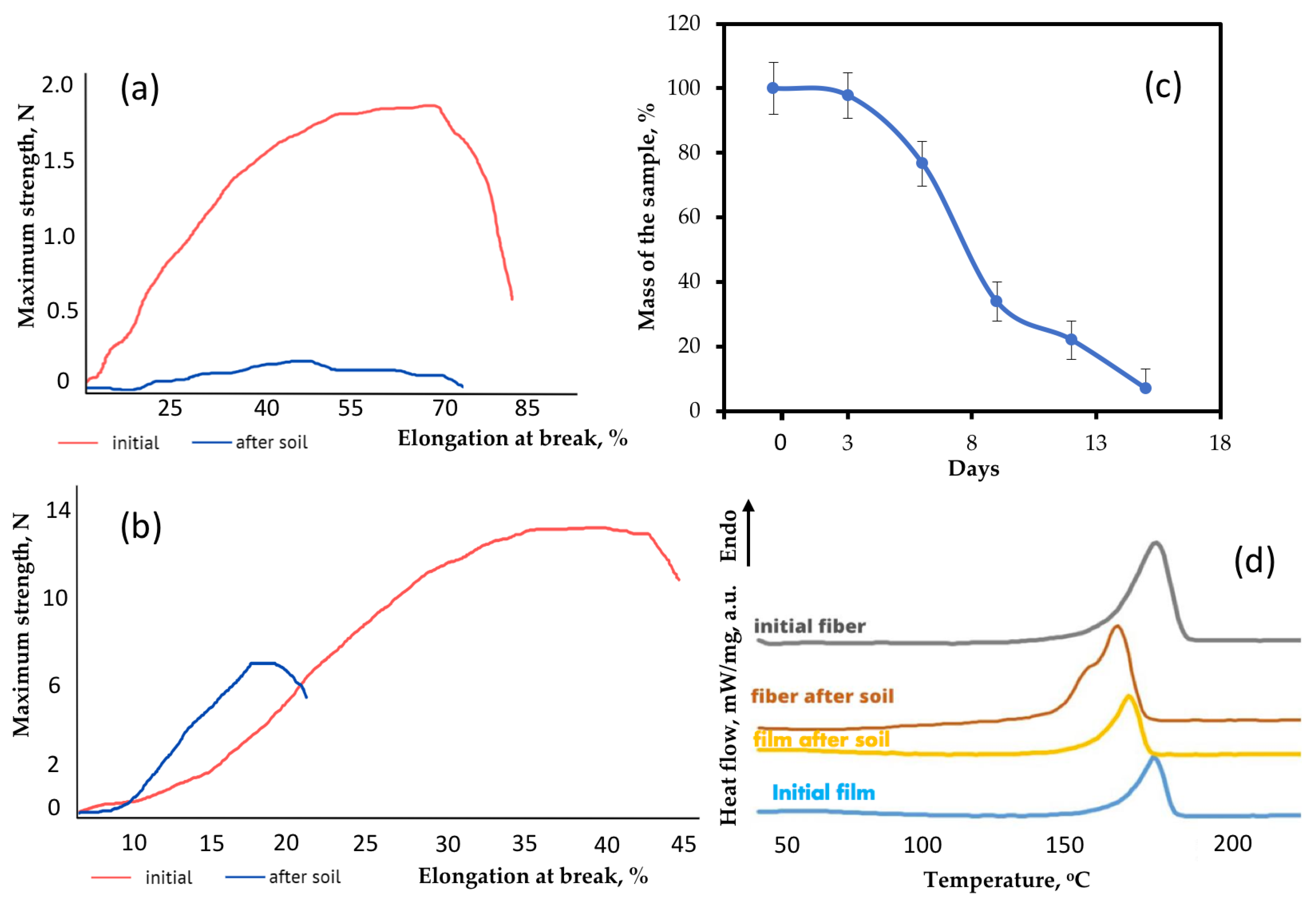
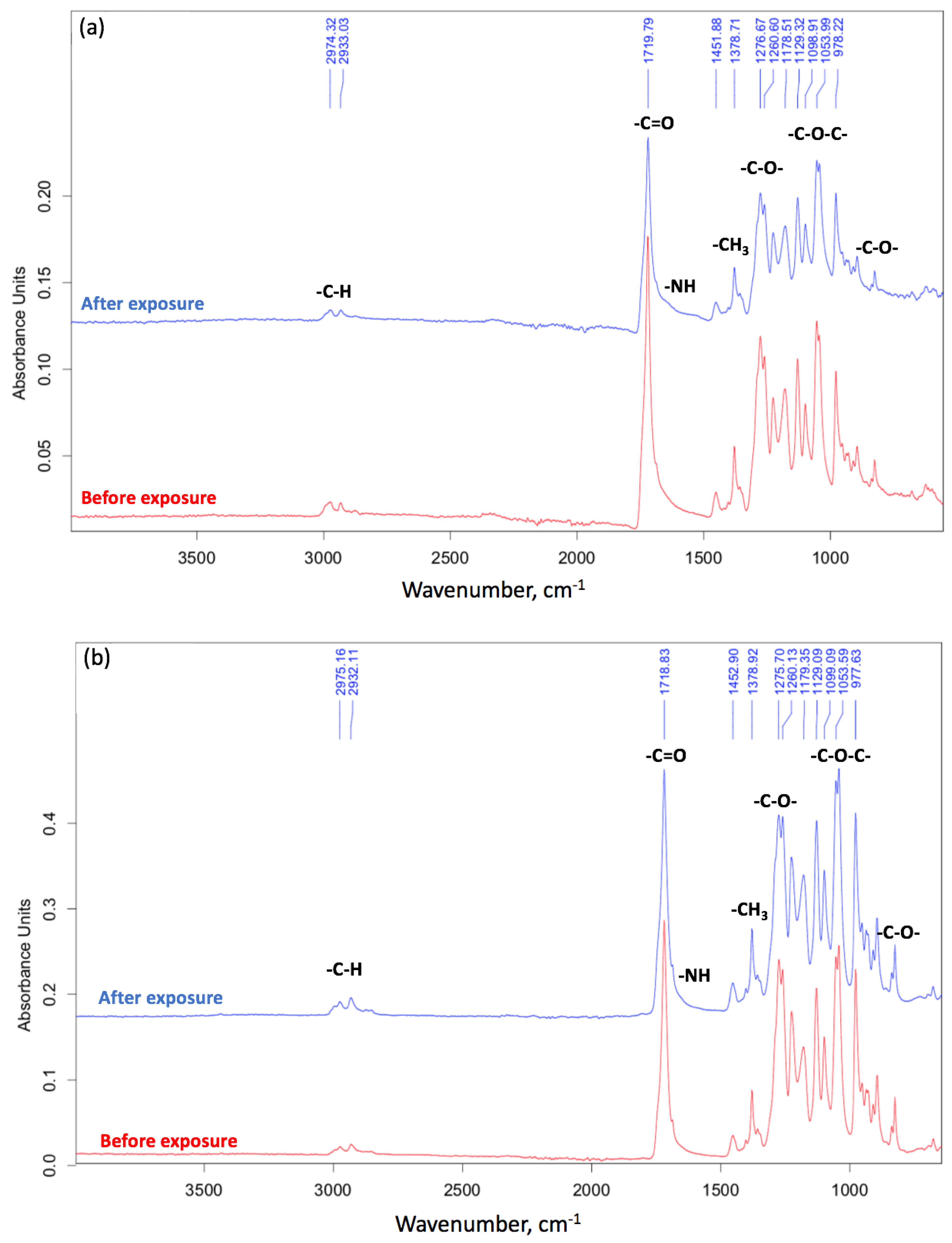
| Additives | Effect |
|---|---|
| Glycerol-based additives: glycerol triacetate (GTA), glycerol tributyrate (GTB) [10] | Act as nucleating agents, thermal stability |
| Hydroxyvalerate and hydroxyhexanoate [11] | Increased toughness |
| Triethyl citrate [12] | Improves mechanical, dynamic-mechanical and thermal properties |
| Acetyl o-tributyl citrate (ATBC) and tributyl citrate (TBC) [13] | Improvement of thermal, mechanical and barrier properties |
| Sugarcane bagasse [14] | cheaper materials, good fertilizers |
| Material | , g/m3 | Porosity, (±SD, n = 10) W,% |
|---|---|---|
| Fibrous material | 0.098 ± 0.01 | 80 ± 2.0 |
| Film | 0.155 ± 0.03 | 6 ± 1.0 |
| Material | Maximum Strength, Fmax, N | Elongation at Break, ε, % |
|---|---|---|
| Fibrous material | 1.91 | 67.53 |
| Fibrous material after soil (8 days) | 0.16 | 49.93 |
| Initial film | 12.34 | 45.75 |
| Film after soil (90 days) | 6.31 | 19.61 |
Disclaimer/Publisher’s Note: The statements, opinions and data contained in all publications are solely those of the individual author(s) and contributor(s) and not of MDPI and/or the editor(s). MDPI and/or the editor(s) disclaim responsibility for any injury to people or property resulting from any ideas, methods, instructions or products referred to in the content. |
© 2023 by the authors. Licensee MDPI, Basel, Switzerland. This article is an open access article distributed under the terms and conditions of the Creative Commons Attribution (CC BY) license (https://creativecommons.org/licenses/by/4.0/).
Share and Cite
Gasparyan, K.G.; Tyubaeva, P.M.; Varyan, I.A.; Vetcher, A.A.; Popov, A.A. Assessing the Biodegradability of PHB-Based Materials with Different Surface Areas: A Comparative Study on Soil Exposure of Films and Electrospun Materials. Polymers 2023, 15, 2042. https://doi.org/10.3390/polym15092042
Gasparyan KG, Tyubaeva PM, Varyan IA, Vetcher AA, Popov AA. Assessing the Biodegradability of PHB-Based Materials with Different Surface Areas: A Comparative Study on Soil Exposure of Films and Electrospun Materials. Polymers. 2023; 15(9):2042. https://doi.org/10.3390/polym15092042
Chicago/Turabian StyleGasparyan, Kristina G., Polina M. Tyubaeva, Ivetta A. Varyan, Alexandre A. Vetcher, and Anatoly A. Popov. 2023. "Assessing the Biodegradability of PHB-Based Materials with Different Surface Areas: A Comparative Study on Soil Exposure of Films and Electrospun Materials" Polymers 15, no. 9: 2042. https://doi.org/10.3390/polym15092042
APA StyleGasparyan, K. G., Tyubaeva, P. M., Varyan, I. A., Vetcher, A. A., & Popov, A. A. (2023). Assessing the Biodegradability of PHB-Based Materials with Different Surface Areas: A Comparative Study on Soil Exposure of Films and Electrospun Materials. Polymers, 15(9), 2042. https://doi.org/10.3390/polym15092042







